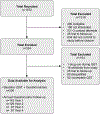Multimodal hypersensitivity derived from quantitative sensory testing predicts pelvic pain outcome: an observational cohort study
- PMID: 37226937
- PMCID: PMC10440257
- DOI: 10.1097/j.pain.0000000000002909
Multimodal hypersensitivity derived from quantitative sensory testing predicts pelvic pain outcome: an observational cohort study
Abstract
Multimodal hypersensitivity (MMH)-greater sensitivity across multiple sensory modalities (eg, light, sound, temperature, pressure)-is associated with the development of chronic pain. However, previous MMH studies are restricted given their reliance on self-reported questionnaires, narrow use of multimodal sensory testing, or limited follow-up. We conducted multimodal sensory testing on an observational cohort of 200 reproductive-aged women, including those at elevated risk for chronic pelvic pain conditions and pain-free controls. Multimodal sensory testing included visual, auditory, and bodily pressure, pelvic pressure, thermal, and bladder pain testing. Self-reported pelvic pain was examined over 4 years. A principal component analysis of sensory testing measures resulted in 3 orthogonal factors that explained 43% of the variance: MMH, pressure pain stimulus response, and bladder hypersensitivity. The MMH and bladder hypersensitivity factors correlated with baseline self-reported menstrual pain, genitourinary symptoms, depression, anxiety, and health. Over time, MMH increasingly predicted pelvic pain and was the only component to predict outcome 4 years later, even when adjusted for baseline pelvic pain. Multimodal hypersensitivity was a better predictor of pelvic pain outcome than a questionnaire-based assessment of generalized sensory sensitivity. These results suggest that MMHs overarching neural mechanisms convey more substantial long-term risk for pelvic pain than variation in individual sensory modalities. Further research on the modifiability of MMH could inform future treatment developments in chronic pain.
Trial registration: ClinicalTrials.gov NCT02214550.
Copyright © 2023 International Association for the Study of Pain.
Figures





Similar articles
-
Cortical mechanisms of visual hypersensitivity in women at risk for chronic pelvic pain.Pain. 2022 Jun 1;163(6):1035-1048. doi: 10.1097/j.pain.0000000000002469. Epub 2021 Aug 27. Pain. 2022. PMID: 34510138 Free PMC article.
-
Clinical profile of comorbid dysmenorrhea and bladder sensitivity: a cross-sectional analysis.Am J Obstet Gynecol. 2020 Jun;222(6):594.e1-594.e11. doi: 10.1016/j.ajog.2019.12.010. Epub 2019 Dec 20. Am J Obstet Gynecol. 2020. PMID: 31870730 Free PMC article.
-
Noninvasive experimental bladder pain assessment in painful bladder syndrome.BJOG. 2017 Jan;124(2):283-291. doi: 10.1111/1471-0528.14433. BJOG. 2017. PMID: 28012262 Free PMC article.
-
Association between dysmenorrhea and chronic pain: a systematic review and meta-analysis of population-based studies.Am J Obstet Gynecol. 2020 Sep;223(3):350-371. doi: 10.1016/j.ajog.2020.03.002. Epub 2020 Mar 7. Am J Obstet Gynecol. 2020. PMID: 32151612
-
Behavioural modification interventions for medically unexplained symptoms in primary care: systematic reviews and economic evaluation.Health Technol Assess. 2020 Sep;24(46):1-490. doi: 10.3310/hta24460. Health Technol Assess. 2020. PMID: 32975190 Free PMC article.
Cited by
-
Deciphering nociplastic pain: clinical features, risk factors and potential mechanisms.Nat Rev Neurol. 2024 Jun;20(6):347-363. doi: 10.1038/s41582-024-00966-8. Epub 2024 May 16. Nat Rev Neurol. 2024. PMID: 38755449 Review.
-
Hal, how many types of pelvic pain are there?Pain. 2024 Sep 1;165(9):1897-1898. doi: 10.1097/j.pain.0000000000003219. Epub 2024 Mar 12. Pain. 2024. PMID: 38564003 Free PMC article. Review. No abstract available.
-
Multimodal hypersensitivity and somatic symptoms predict adolescent postmenarchal widespread pain.Pain. 2025 Apr 29:10.1097/j.pain.0000000000003597. doi: 10.1097/j.pain.0000000000003597. Online ahead of print. Pain. 2025. PMID: 40288817
-
Independent effects of transcranial direct current stimulation and social influence on pain.Pain. 2025 Jan 1;166(1):87-98. doi: 10.1097/j.pain.0000000000003338. Epub 2024 Jul 12. Pain. 2025. PMID: 39167466 Clinical Trial.
References
-
- Abdi H Singular Value Decomposition (SVD) and Generalized Singular Value Decomposition (GSVD). Thousand Oaks, CA: Sage, 2007.
-
- Abdi H, Williams LJ. Principal component analysis. WIREs Comp Stat 2010;2:433–459.
-
- Andersson HI. The course of non-malignant chronic pain: a 12-year follow-up of a cohort from the general population. European Journal of Pain 2004;8:47–53. - PubMed
-
- Apkarian AV, Bushnell MC, Treede R-D, Zubieta J-K. Human brain mechanisms of pain perception and regulation in health and disease. European Journal of Pain 2005;9:463–463. - PubMed
-
- Arendt-Nielsen L Mechanistic similarities between fibromyalgia and other chronic pain conditions. PAIN Reports 2017;2:3.
Publication types
MeSH terms
Associated data
Grants and funding
LinkOut - more resources
Full Text Sources
Medical
Research Materials
Miscellaneous

